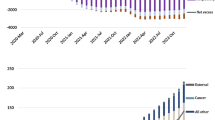Abstract
Tobacco exposure is the major risk factor for lung cancer. Previous studies have shown that there is a correlation between tobacco consumption and lung cancer mortality, but they do not show a specific trend. This study established the polynomial distributed lags (PDLs) model to explore the distributional lag effect between tobacco consumption and lung cancer mortality by using the lung cancer mortality rate of residents in Henan Province and the annual per capita tobacco consumption data from 1992 to 2016 and adopted dynamic simulation prediction method to predict lung cancer mortality for the next 20 years. We found that per capita tobacco consumption had a 10-year lag effect on lung cancer mortality. The harm of tobacco consumption did not show in the first 4 years, but after a lag of 4 years or more, the lung cancer mortality in men was higher than that in women, with a peak effect occurring 10 years later. The prediction showed that if per capita tobacco consumption was controlled, lung cancer mortality would show a steady decline trend after 10 years. These results suggested that tobacco consumption and lung cancer mortality were asynchronous, with a lag effect of tobacco use on the occurrence of lung cancer.



Similar content being viewed by others
Availability of data and materials
The datasets used and/or analyzed during the current study are available from the corresponding author on reasonable request.
References
Adair T, Hoy D, Dettrick Z, Lopez AD (2011) Reconstruction of long-term tobacco consumption trends in Australia and their relationship to lung cancer mortality. Cancer Causes Control 22(7):1047–1053
Barnoya J, Glantz S (2004) Association of the California tobacco control program with declines in lung cancer incidence. Cancer Causes Control 15:689–695
Cao M, Chen W (2019) Epidemiology of lung cancer in China. Thorac Cancer 10(1):3–7
Chen WQ, Li H, Sun KX, Zheng RS, Zhang SW, Zeng HM, Zou XN, Gu XY, He J (2018) Report of Cancer Incidence and Mortality in China, 2014. Zhonghua Zhong Liu Za Zhi 40(1):5–13
Chinese Center for Disease Control and Prevention(2015). China adult tobacco survey report in 2015. http://www.chinacdc.cn/jkzt/sthd_3844/slhd_4156/. Accessed 28 Dec 2015
Doll R, Hill AB (1950) Smoking and carcinoma of the lung. Br Med J 2(4682):739–748
Global Health Data Exchange(2018). GBD Results Tool. Available online: http://ghdx.healthdata.org/gbd-results-tool. Accessed June 10
Jemal A, Thun MJ, Ries LA, Howe HL, Weir HK, Center MM, Ward E, Wu XC, Eheman C, Anderson R, Ajani UA, Kohler B, Edwards BK (2008) Annual report to the nation on the status of cancer, 1975–2005, Featuring Trends in Lung Cancer, Tobacco Use, and Tobacco Control. J Natl Cancer Ins 100(23):1672–1694
Jemal A, Ward EM, Johnson CJ, Cronin KA, Ma J, Ryerson B, Mariotto A, Lake AJ, Wilson R, Sherman RL, Anderson RN, Henley SJ, Kohler BA, Penberthy L, Feuer EJ, Weir H (2017). Annual Report to the Nation on the Status of Cancer, 1975–2014, Featuring Survival. J Natl Cancer Inst.109(9): djx030
Luo Q, Yu XQ, Wade S, Caruana M, Pesola F, Canfell K, O'Connell DL (2018). Lung cancer mortality in Australia: projected outcomes to 2040.Lung Cancer. 125: 68–76.
Ma L, Sun JF, Feng LY(2013) Research on the association between per-capita tobacco consumption among the permanent residents and lung cancer mortality in Henan province. Zhonghua Liu Xing Bing Xue Za Zhi 34(7):711–713
Schwartz J (2000) The distributed lag between air pollution and daily deaths. Epidemiology 11(3):320–326
Wingo PA, Ries LA, Giovino GA, Miller DS, Rosenberg HM, Shopland DR, Thun MJ, Edwards BK (1999). Annual report to the nation on the status of cancer, 1973–1996, with a special section on lung cancer and tobacco smoking. J Natl Cancer Inst. 21; 91(8):675–90.
Wu X, Zhu B, Xu S, Liu Y, Bi Y, Zhou B (2020). A comparison of the burden of lung cancer attributable to tobacco exposure in China and the USA.Ann Transl Med. 8(21):1412
Yang GH, Ma JM, Liu N, Zhou LN (2005) Smoking and passive smoking in Chinese, 2002. Chinese Journal of Epidemiology 26(2):77–83
Zanobetti A, Schwartz J, Samoli E, Gryparis A, Touloumi G, Peacock J, Anderson RH, Le Tertre A, Bobros J, Celko M, Goren A, Forsberg B, Michelozzi P, Rabczenko D, Hoyos SP, Wichmann HE, Katsouyanni K (2003) The temporal pattern of respiratory and heart disease mortality in response to air pollution. Environ Health Perspect 111:1188–1193
Acknowledgements
We would like to acknowledge Prof. Xibin Sun, Henan provincial cancer monitoring center, PhD Kunkun Xue, and Associate Prof. Fei Chen, Business School of Zhengzhou University, for their valuable advice during the data collection and the operation of software.
Funding
This study was supported by the Key R&D and promotion projects in Henan Province (grant 212102310195). And the funding sources had no involvement in study design, collection, analysis, interpretation of data, writing of the report, or the decision to submit the article for publication.
Author information
Authors and Affiliations
Contributions
JL and LM collected data. LF designed the study, and CW and XD reviewed the final paper. All drafts were written by LL and commented on by all authors. All authors read and approved the final manuscript.
Corresponding author
Ethics declarations
Ethics approval and consent to participate
This study is a secondary analysis of a public access dataset of the China’s Henan Province tumor monitoring center and Henan statistical yearbook. It does not contain any identifiable information of the participants. The study was reviewed and approved by the Institutional Review Boards of the School of Public Health, Zhengzhou University in China.
Consent for publication
Not applicable.
Competing interests
The authors declare no competing interests.
Additional information
Responsible Editor: Lotfi Aleya
Publisher’s note
Springer Nature remains neutral with regard to jurisdictional claims in published maps and institutional affiliations.
Supplementary Information
Below is the link to the electronic supplementary material.
Rights and permissions
About this article
Cite this article
Li, L., Lu, J., Dai, X. et al. The lag effect of 24-year tobacco consumption on lung cancer mortality in Henan Province, China, 1992 to 2016. Environ Sci Pollut Res 29, 22483–22489 (2022). https://doi.org/10.1007/s11356-021-17302-y
Received:
Accepted:
Published:
Issue Date:
DOI: https://doi.org/10.1007/s11356-021-17302-y




